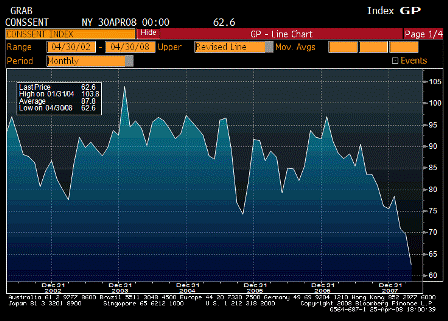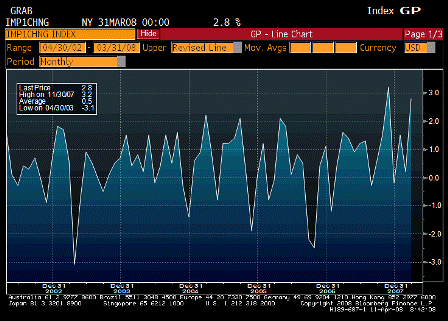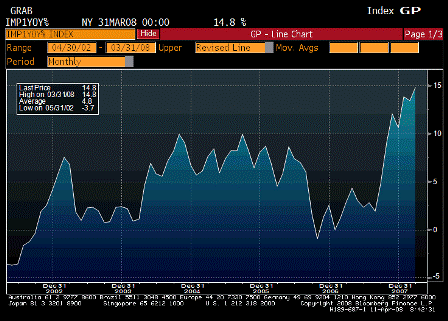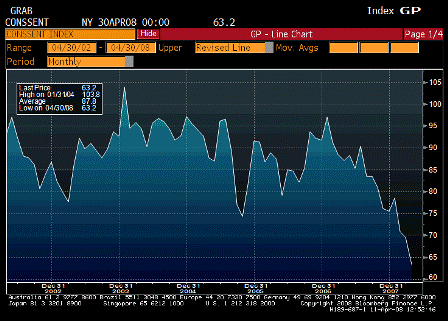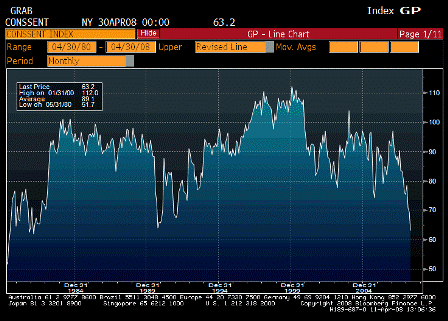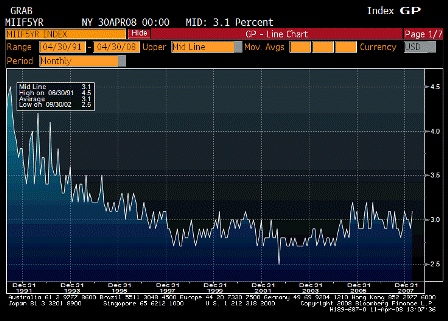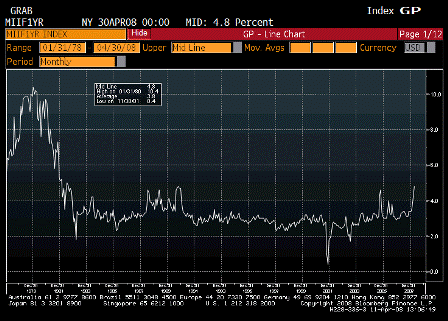Why Deficits Still Matter
by Austan Goolsbee
Chief economic adviser to Obama.
The United States has run massive budget deficits every year the Bush administration has been in office. The latest budget projections from the White House show annual deficits in the $250 billion range for the rest of the president’s term, at which point nearly $3 trillion will have been added to the national debt.
And thereby added to aggregate demand, non-government income, and ‘savings’ of financial assets.
1
In fact, George W. Bush has presided over the biggest fiscal deterioration in American historyâ€â€Âa sorry legacy considering his predecessor left him a healthy budget surplus projected to be $5 trillion over 10 years.
The budget surplus drained the savings of net financial assets of the non-government sectors, and thereby ended the recovery triggered by the large deficits of the early 1990s.
The Bush fiscal reversal helped restore aggregate demand, growth, and employment.
Austan Goolsbee is a senior economist for PPI and the Democratic Leadership Council. This did not happen by accident. White
House officials have repudiated the Clinton administration’s view that fiscal responsibility lays the groundwork for sustained economic growth.
And rightly so.
Government deficit = Non-government ‘surplus’ (savings of financial assets) as a matter of accounting, not theory.
Often identified with former Treasury Secretary Robert Rubin, this view held that by running massive deficits
Adding to aggregate demand.
and borrowing heavily,
‘Borrowing’ only ‘offsets operating factors’ to give non-interest bearing deposits created by deficit spending and ‘borrowing’ only ‘offsets operating factors’ to give non-interest bearing deposits created by deficit spending as interest bearing alternative in order to keep the Fed Funds rate at the FOMC’s target level.
the federal government drove up the cost of capital.
The Fed votes on the interest rate, and the cost of capital includes a risk adjustment as well.
NOTE: A few years ago, Japan had a debt of 150% of GDP, annual deficits of 7%, and 10-year interest rates under 1%.
By cutting the deficit, it could bring interest rates down
Only if it causes a slowdown that causes the Fed to cut rates.
and thereby stimulate new waves of private investment.
No, a slowdown does not encourage private investment.
The economic boom of the 1990s seemed to prove Rubinomics right.
No. The high deficits of the early 1990s triggered the expansion, and the surplus of the late 1990s ended it.
But Republicans have nonetheless rejected that approach. Glenn Hubbard, formerly President Bush’s top economic adviser, said in a December 2002 speech: “One can hope that the discussion will move away from the current fixation with linking budget deficits with interest rates.” When pressed on the point, he responded: “That’s Rubinomics, and we think it’s completely wrong.”
Hubbard is right on that point, but he still favors lower deficits; so, he’s ultimately wrong as well.
2
More recently, in an editorial marking the 25th anniversary of Ronald Reagan’s inauguration, the conservative Wall Street Journal opined that Rubinomics was a failure, and argued that history had vindicated the supply-side line that tax cuts are the most important policy that government can undertake.
They think tax cuts are good because through growth they ‘raise more revenue than they cost’ and bring down the deficit that way.
Their goal is the same: to bring down deficits.
3
Meanwhile, the Bush White House has pointed to higher-than-expected tax revenues in the last two years as further proof that we do not need to worry about fiscal responsibility in the near future.
Right, both believe lower deficits are ‘better’; both miss the point.
Times have changed since 1992, and the economic case for fiscal discipline has changed, too. But it remains strong.
Wrong.
It is true that the globalization of capital markets in the last 15 years means that America no longer displaces an inordinate percentage of the world’s capital when it borrows heavily from abroad.
We have no imperative to borrow from abroad. He has it all backwards, as does most everyone else. In fact, US domestic credit funds foreign savings.
Therefore, the interest rates that the U.S. government has to pay for its massive borrowing are not as high as they might be
The Fed sets the rates by voting on them.
The left and the right have gone far astray from the economic fundamentals.
otherwise. In addition, governments and central banks have helped our situation. Lending countries such as China and the world’s oil exporting nations seemingly have been willing to hold U.S. debt even though higher returns might be available elsewhere.
Yes, to support their exports. But now that Paulson and Bush have ‘successfully’ caused them to change policy by calling them currency manipulators and outlaws, they no longer are accumulating USD financial assets at previous rates.
This has caused the USD to begin falling to the levels that coincide with rising US exports and falling imports.
It won’t stop until the US trade gap gets to levels that equate it with desired USD accumulation levels of foreigners. Could be near zero.
Of course, it is nice to be able to borrow money without having to worry much about the impact on interest rates.
That’s what all governments with non-convertible currency and floating fx do in the normal course of business.
But if globalization has made borrowing from abroad easier, it also exacts new penalties for fiscal profligacy. In fact, there are three big reasons why Americans should still be concerned with big budget deficits: (1) they have unfair distributional consequences between generations;
No, this is inapplicable.
When our children build twenty million cars in 2030, will they have to send them back to 2008 to pay off their debt?
Are we sending goods and services back to 1945 to pay for WWII?
No, each generation gets to consume whatever it produces, and it also can decide the distribution of its consumption.
(2) they make it harder for our government to respond to fiscal crises;
No, government can buy whatever is offered for sale to it. Government spending is not constrained by revenue.
and (3) they subject America’s economic well-being to the potential whims of foreign governments and central banks.
Only to the extent that we might lose the benefits of high real imports.
Imports are real benefits; exports are real costs.
Before looking at each of these, however, it is important to address the administration’s claim that our current fiscal position is basically healthy.
‘Healthy’ is undefined and inapplicable.
The recently released budgets of the Congressional Budget Office (CBO) and of the president show the government going back into surplus by 2012, which makes it sound as though the problem has been solved.
No, sounds like a recession would quickly follow if they press those results.
4
A closer look at the numbers, however, reveals that the positive news is overstated.
Thank goodness – might continue to muddle through and avoid recession after all!
The CBO’s projections, for example, assume that all the Bush tax cuts will expire; that the Alternative Minimum Tax (AMT) will affect a growing fraction of people earning between $75,000 and $100,000 over the next five years; that federal spending will grow only with inflation, rather than with population or GDP growth; and, most importantly, that the federal government will go on raiding the Social Security trust fund “lock-box.” The president, by requesting hundreds of billions of dollars in further tax cuts, has painted himself into such a tight corner that he cannot produce a fiscally responsible budget without leaning heavily on such dubious assumptions.
Hoping he doesn’t succeed!
A more realistic analysis shows very significant deficits for at least the next several years, after which the baby boomers’ exploding health and retirement costs will make the fiscal picture dramatically worse.
He means ‘better’ but doesn’t realize yet.
Make no mistake: Deficits still matter. A balanced budget may be less central to economic growth today than in the 1990s. But deficit reduction now functions as a crucial insurance policy against global financial shocks and over-reliance on foreign lenders,
There is no reliance on foreign lenders. Government is best thought of as spending first, then borrowing to support interest rates.
as well as national emergencies such as Hurricane Katrina’s devastation of the Gulf Coast.
Government can spend however much it wants at any time it wants, unconstrained by revenues.
The constraint is inflation, not revenues, but the author never even mentions inflation.
It should not be a goal in and of itselfâ€â€Âpain for pain’s sake. Fiscal responsibility should be our goal because it remains an important foundation of economic justice and growth.
Justice???
Here is a closer look at the adverse social and economic consequences of the Bush administration’s irresponsible fiscal policies.
Who Will Pay for the Bush Deficits?
Although fiscal policy is seldom viewed through the lens of economic fairness, the first and biggest problem with fiscal irresponsibility is distributional. When we borrow money without paying it back, we are leaving our children and grandchildren a legacy of much higher tax rates and much lower public benefits than we enjoy, because they will have to foot our bill.
As above, they will get to consume whatever they produce, debt or no debt.
Real wealth is not the issue.
And government can distribute current year output any way it wants.
Economists use what is known as “generational accounting” to calculate how much of the nation’s debt burden will need to be borne by later generations compared to ours and previous generations as a function of today’s large fiscal imbalances. The results are stark:
And totally inapplicable.
As a share of their income, future generations will have to pay about twice the taxes as today’s workers have paid or else they will receive around one-half the public spending.
The living will still get all the output, no matter what tax rate they elect to charge themselves.
The money we spend beyond our means today takes away the money our children will have for Social Security benefits, Medicare, Medicaid, and every other spending priority.
And who gets the money that is ‘taken away’ – dead people of the past???
Is he that dense or is this blatant propaganda? Both???
The interest payments on the country’s growing debtâ€â€Âalready accounting for approximately 10 percent of the federal budget, pushing $300 billion dollarsâ€â€Âwill ultimately become the government’s biggest budget item. The payments for the spending of the past will increasingly crowd out the spending priorities of the present.
Crowd out – figured he’d slip that in our of left field.
The country is in for a double disappointment because all these new deficits have not been used for investments. It is one thing to run deficits to invest in activities that might improve productivity or standards of living for future generations. This, after all, is what FDR did to pull America out of the Great Depression and win World War II. A bigger economy would allow us to soften the distributional blow of deficit financing. But that is not what the Bush administration has done. It borrowed to finance huge tax cuts for a fortunate few, and most of the money went straight into consumer spending with little lasting impact on the kids who will one day have to pay the bills for this splurge.
Savings is the accounting record of investment.
In general, investment is a function of demand – nothing like a backlog of orders to spur expansion of output.
Also, technology and cost savings drives investment.
And the point of investment is future output and future consumption.
The whole point of economics is to maximize consumption in the general sense.
How Deficits Handcuff U.S. Policymakers
The second major problem with running big deficits is that it diminishes the government’s ability to respond to crises.
Not. As above.
It eats up the rainy day fund, if you will.
No such thing. Inapplicable. Government spends by crediting accounts.
This is not constrained by revenues.
To that point, if you pay your taxes in cash, the government tosses the cash into a shredder. Clearly it has no use for revenue per se.
When the government operates without the fiscal cushion that budget surpluses provided in the late 1990s, it is hard-pressed to respond to emergencies, such as Hurricane Katrina, or even fulfill more basic commitments.
Only if it’s ignorant of monetary operations and the working of the payment system. (So, maybe he’s right???)
It is especially troubling today that despite an economy in full-blown recovery, record-smashing corporate profits, low interest rates, and strong productivity growth, the country’s budget deficits have still been in the $250 to $400 billion range.
The rising deficit is what’s supporting GDP above recession levels currently.
On top of that, the true size of the fiscal mess is masked by the fact that we are dipping into the Social Security surplus to finance current consumption. Since 2001, we have effectively borrowed almost $1 trillion from the trust fund, and the CBO forecasts another $200 billion or so every year for the foreseeable future. Our true annual deficits have been in the $400 billion to $600 billion range and are forecast to continue in that range for the rest of the Bush term.
Point? Social Security payments are operationally not revenue constrained, just like the rest of government spending.
It’s about inflation, not solvency, but he never mentions that.
What are we going to do in the event of another recession, a decrease in corporate profits, another Hurricane Katrina, a collapse of the Pension Benefit Guarantee Corporation, or another major war? And how will we finance future Social Security and Medicare benefits? The probable answer is, we’ll borrow moreâ€â€Âbut this will only postpone the day of reckoning and make it more severe.
The government can always ‘write the check’ with any size deficit or surplus. Doesn’t matter, apart from inflationary consequences.
The United States has a strategic petroleum reserve to guard against unforeseen disruptions in our oil supply. It is not a long-term solution. It is crisis insurance. Similarly, cutting the deficit would give us a strategic fiscal reserve.
Inapplicable concept with a non-convertible currency and floating fx.
Should bowling allies carry a reserve of ‘score’ to make sure you get your score if you knock the pins down???
Without it, the country must either raise taxes to deal with a crisis or else significantly increase the federal debt burden, which already totals almost $80,000 for every household in America.
So???
Foreign Leverage Over the U.S. Economy
The third risk of today’s fiscal irresponsibility is the negative impact it has on our international positionâ€â€Âboth economic and, potentially, geopolitical. Our economic position is seriously undermined by a low savings rateâ€â€Âand the deficit is like an anchor that drags our national savings rate down.
Not the ‘national savings’ rhetoric again!!!
That’s a gold standard construct. Back then, when the US went into debt, it was obligated to repay in gold certificates and ultimately gold itself.
Borrowing was getting short gold and/or depleting our gold reserves.
Our national savings was defined as our gold reserves.
This is ALL no longer applicable and no longer presents a fiscal constraint.
We need to get our low savings rate up.
Inapplicable.
One of the stated goals of the big tax cuts the president pushed through a compliant GOP Congressâ€â€Âincluding dividend tax cuts, capital gains tax cuts, estate tax cuts, and top-bracket income tax cutsâ€â€Âwas to increase incentives for high-income people to save. On the most practical level imaginable, this policyâ€â€Âcall it Supply Side 101â€â€Âhas failed. The savings of high-income people have not increased dramatically, certainly not enough to offset the plunge in the national savings rate that the big Bush deficits represent (because a nation’s savings rate combines personal, corporate, and government savings). For a country to maintain investment by entrepreneurs and companies when there is not enough domestic capital to be had,
Savings is not ‘domestic capital to be had’
He is shamelessly mixing metaphors.
Loans create deposits. Capital grows endogenously. He should know that.
it must by necessity borrow from abroad.
Wrong. Loans create deposits. Not the reverse as he implies.
It is a good sign for the economy that our investment rateâ€â€Âthe part of GDP spent on machinery, capital, buildings, factories, and the likeâ€â€Âhas finally recovered from the recession of the early 2000s.
Due to the $700 billion fiscal shift from surplus to deficit.
But because that investment has been coupled with low national savings, the United States has had to borrow an astounding amount of money from foreign countries.
He has the causation backwards.
Domestic credit creation funds foreign savings, not vice versa.
Foreign ownership of U.S.
Treasuries alone increased $1.2 trillion dollars in the first five years of the Bush administration, after falling more than $200 billion in the last two and a half years of the Clinton administration. Most often it is foreign governments and central banks that own our debt. That is what raises the potential threat to America’s geopolitical position.
How??? The risk is theirs, not ours!
It is certainly less concrete than the impact on the savings rate, but the impact of borrowing on America’s geopolitical posture might be important in the event of a crisis. Because America has had to borrow from abroad,
It doesn’t ‘have to’ at all. There is no such thing, as above.
it has ended up owing a great deal of money to governments whose interests do not always mesh with our own. Our government owes China some $350 billion, for example, and we owe oil exporting countries such as Saudi Arabia, Libya, Algeria, Venezuela, and Qatar a combined $100 billion more.
That’s their problem, not ours. We already got the real goods and services from them. They are holding undefined ‘paper’.
Most of the time, it does not matter who holds a country’s debt. Investors around the world, no matter who they are, simply respond to market forces. But in times of crisis, if investors happen to be the governments and central banks of other countriesâ€â€Âas is predominantly the case today with U.S. debtâ€â€Âthen lenders can have inordinate influence over a borrower’s international policies.
Hard pressed to find an example if he uses this one:
Take one example from our own history: the Suez crisis of 1956. Britainâ€â€Âwhich was heavily indebted to the United Statesâ€â€Âjoined with France and Israel in an invasion of Egypt after Egypt’s president, Gamel Abdel Nasser, nationalized the Suez canal. The Eisenhower administration, which had lambasted the Soviet Union’s invasion of Hungary that same year, was determined to keep its anti-colonial credentials intact by opposing the British-French venture. The United States refused to float its World War II ally further loans to
support their currencyâ€â€Âand even threatened to dump its holdings to precipitate a currency crisis. The British, desperate to avoid a devaluation of the pound,
There’s the rub – they had a fixed exchange rate they wanted to support.
With floating fx, this isn’t the case.
caved in, and the Suez misadventure heralded the end of European colonialism in the Arab world. Could other countries exercise the same kind of economic leverage over the United States? Hopefully, we are a long way from having that sort of situation in reverseâ€â€Âwhere
our foreign policy goals are stymied because of financial pressures from our debt holdersâ€â€Âbut it is not inconceivable that we would be forced to choose between our geopolitical goals and financing the debt we owe foreign countries.
It should be inconceivable because it is inapplicable with floating fx.
This debt is primarily owned by governments with political motives, not just economic ones. If these governments decided to dump U.S. treasuries, we could plunge into crisis mode. Since there is not enough domestic savings to cover our investment, either our investment rate would need to fall, or interest rates might need to shoot up in order to attract capital from somewhere else.
There is no imperative to ‘attract foreign capital’.
This is just plain wrong.
Either way, it would be bad news for the U.S. economy.
Maybe for inflation, but he never goes there.
Further, as the risks associated with our accumulating debt grow, oil exporting countries will be tempted to sign their contracts in euros or yen rather than dollars, as they do now.
Doesn’t matter; it’s just a numeraire.
If that happens, then anything that devalues the dollarâ€â€Âincluding policy initiatives designed to reduce the trade deficitâ€â€Âwill directly increase the price of energy rather markedly.
Saudis are price setters in crude for other reasons – that’s the source of crude price hikes.
A Legacy for Future Generations
Given the hazards of continuing down the current path of fiscal excess, Congress should act soon to get things under control. That does not mean immediately balancing the budget by draconian cuts to necessary investments. Small deficitsâ€â€Âsay on the order of 1 percent of GDPâ€â€Âwill not run the economy into the ground and occasional big expenses on emergencies like Hurricane Katrina are a fact of modern life.
Too small to sustain aggregate demand. Probably need around 5% deficits from the evidence of the last twenty years.
But we know that entitlement spending will grow dramatically in the next 20 years and we need to make space in the trunk for a few very large suitcases, as it were. We should not be filling up the space before those bags even arrive.
Inapplicable.
The debt our generation accumulates becomes part of the legacy we leave to the next generation. The “greatest generation” that fought WWII sacrificed a great deal for the next generationâ€â€Âfor us, their children and grandchildren. Not only did some give their lives, but over the next 20 years they largely paid off all of the massive debt they had to accumulate during the war.
We’ve averaged 3-5% deficits for a long time which have supported growth and employment, and avoided a depression.
At the end of the war, America’s debt exceeded its entire GDP. By the Kennedy administration, the ratio was back down to the same level it was before the war.
But the nominal amount continued to grow, and when it didn’t, the economy suffered.
Opportunity, not debt, was the legacy our grandparents wanted to leave behind.
Endnotes
1
“Budget of the United States Government, Fiscal Year 2008,” Office of Management and Budget, http://
www.whitehouse.gov/omb/budget/fy2008/budget.html.
2
Chait, Jonathan,”Deficit Reduction,” The New Republic, January 13, 2003.
3
“Still Morning in America: Reaganomics 25 Years Later,” Wall Street Journal Editorial, January 20, 2006, http://
www.opinionjournal.com/editorial/feature.html?id=110007843.
4
See:”Budget of the United States Government, Fiscal Year 2008,” op cit., and “The Budget and Economic Outlook:
Fiscal Years 2008 to 2017,” Congressional Budget Office, http://www.cbo.gov/ftpdocs/77xx/doc7731/01-24-
BudgetOutlook.pdf.
[top]

